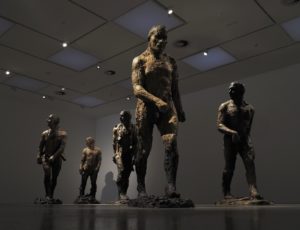
Laurence Edwards | A Gathering of Uncertainties
by Fiona Gruber, writer and broadcaster
Laurence Edwards’s studio is in an old fire station in Saxmundham, Suffolk; a tree grows through its glass roof and trails leafy branches into the scruffy white space where he makes his work. Figures and heads of varying sizes and attitudes populate the shelves and floor and the red clay he uses to fashion them with sits in the corners of the room. It has been recycled again and again and in spring the fissures in these earthy lumps, waiting to be turned into yet more creatures, sprout bright sprigs of grass and delicate fungi and even give shelter to the odd toad. All this delights Edwards, as do the ancient, blackened tree roots that pop up out of the rich peaty soil in this part of the world. They ooze a dark tar-like liquid and the calves and feet of his Walking Men look like they have waded through this viscous substance.
“These reference the coast line,” he explains, pointed to the tidemarks on the sculptures’ darkened shins; “they evoke the patina of the eroding cliffs and that tarriness, as if they’d been dipped in the marshes,” he says.
Place is very important to Edwards and this stretch of curving East Anglian coastline, famed for its shingled shores and plethora of ice-age fossils, as well as its rolling fields and woodland, is where he grew up. His sculptures have appeared standing and floating in its estuaries, they have marched through its verdant meadows and, in the case of the Yoxman, erected in 2021, stand mutely sentinel, a rough-hewn colossus almost eight metres tall.
With their slabby pitted surfaces and slurried patinas, Laurence Edwards’s figures appear to have been roughly formed from the clay of creation. They are encrusted with the organic adhesions – twigs, twine, grass, leaves – that come from being born of the soil but also of having travelled through landscapes and interacted with them. Whether at rest or in motion, Edwards’s sculptures are explorers in a world of changing circumstance.
His figures suggest both potency and fragility; he is fascinated by the idea of mutation and entropy, a concept in science that is most commonly associated with disorder and randomness, of change, but which applies equally in a socio-historical context and in the context of making.
In his native England, Edwards’s sculptures, in their rough nakedness, are often viewed as ancient humans from the dawn of time, ancestral creatures who only faintly echo the modern human condition. But this is not how the artist sees them; his men– and they are always male – are both timeless and in all times, including the here and now. “They are a manifestation of a myriad of mistakes,” he says, referring not to any errors in the process of their creation so much as the fallibility of existence.
Edwards’s relationship with Australia began in 2013 and he has exhibited here several times. Through travelling, his sculptures have attracted new narratives. One in particular, After the Flood, a figure which seems to sprout wings, or a yoke of organic debris, originally had the title The Catcher. In its initial iteration, Edwards saw the man’s burden as personal and psychological but after learning of the devastating floods that sweep the eastern States with increasing frequency, he began to see the figure in a new light.
“The idea of this character standing in the wake of an ebbing tide after a deluge intrigued me. The metaphors I was thinking through before were personal and psychological, now a whole environmental aspect rose its head; this character could be a monitor, an evidence collector, a barometer even of our relationship to nature,” he explains.
A Gathering of Uncertainties explores masculinity as a fractured state; his figures are Ur-males in varying attitudes of being; some are patient and stoic, nurturers and builders, others are angry and fearful, as if switching between being predatory and being hunted. They are both survivors and colonisers in harsh environments, terrains that they have shaped, for ill and for good.
Edwards, one of the most prominent figurative sculptors in Britain today, is also distinguished by running his own foundry. It is a few miles from his studio and it is here that he transforms his people, from clay into wax using the Lost Wax system, where a mould made from the wax figure is filled with molten bronze.
Edwards describes his chosen medium as art metal, due to its long and varied cultural associations; bronze, an alloy of tin and copper has been worked for millennia from the Americas to China and alongside degrees in sculpture and bronze casting in the UK, Edwards has studied the ancient West Asian craft of casting with experts in India and Nepal. Whilst he is rooted in the soil of his homeland, his figures bear traces of many cultures.
But alongside being an “art metal”, bronze has also been the medium of choice over the millennia and across the globe for civic trumpet-blowing; the erectors of monuments have been overwhelmingly men glorifying other men. This association also comes to mind when viewing Edwards’s male figures and yet his work is the antithesis of triumphalism.
His sculptures create a psychological narrative where figures seemed poised between fight or flight in times of crisis; the brutality of invasion, the ecological catastrophe or the personal meltdown.
Whether it is his Walking Men, his crouching man, the burdened carrier in Heft or the watchfulness of his figures in Barrage, Edwards deconstructs the whole aggrandising, patriarchal history of bronze statues in his doubting, doubtful beings; no heroes have been erected in their making, no excuses have been made and a tradition of figurative bronze sculpture has been radically, daringly re-imagined.